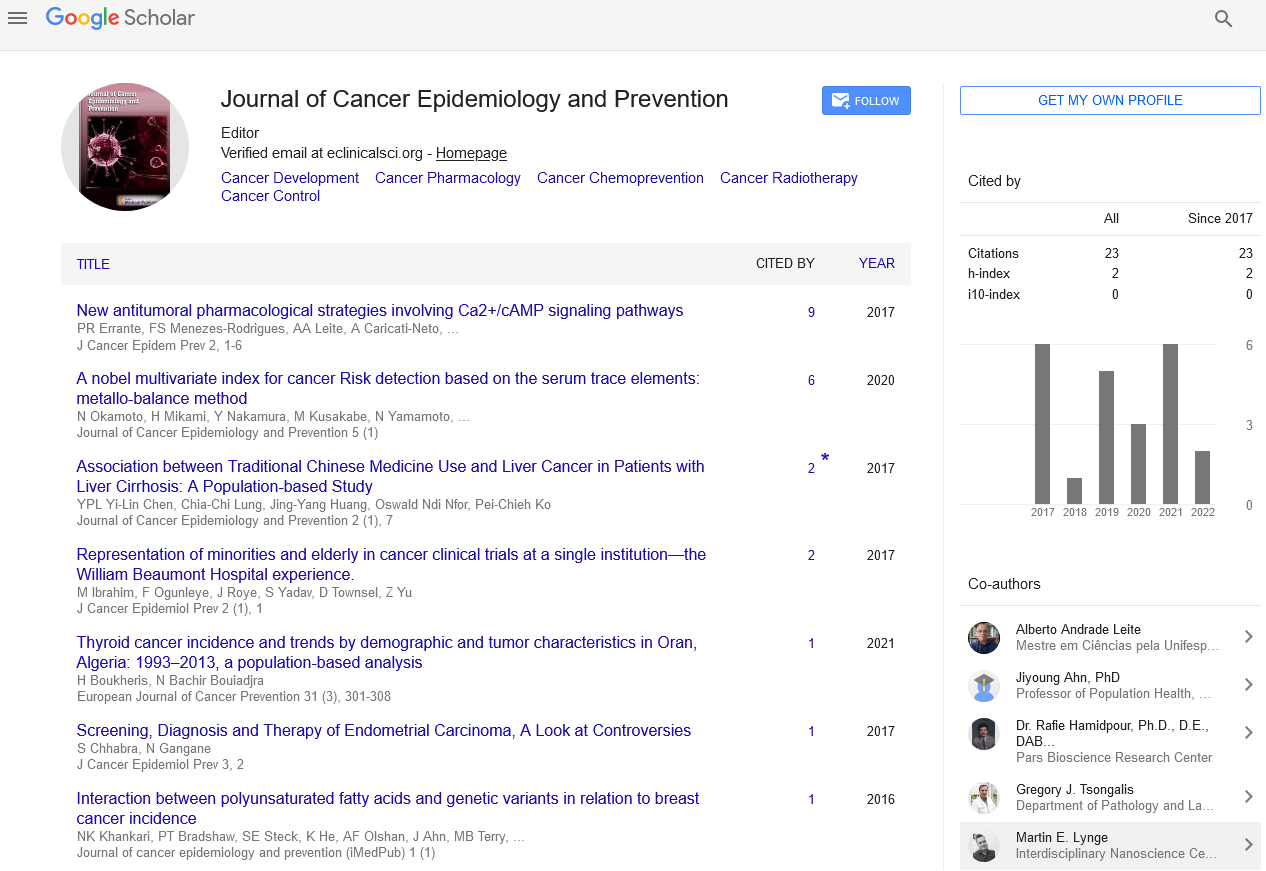Short Communication - (2024) Volume 9, Issue 3
Understanding the Breast Cancer: In Depth Exploration
Ren Kato*
Department of Radiology, University of Waseda, Japan
*Correspondence:
Ren Kato,
Department of Radiology, University of Waseda,
Japan,
Email:
Received: 02-Sep-2024, Manuscript No. IPJCEP-24- 21216;
Editor assigned: 04-Sep-2024, Pre QC No. IPJCEP-24- 21216 (PQ);
Reviewed: 18-Sep-2024, QC No. IPJCEP-24- 21216;
Revised: 23-Sep-2024, Manuscript No. IPJCEP-24- 21216 (R);
Published:
30-Sep-2024, DOI: 10.36648/IPJCEP.24.09.22
Introduction
Breast cancer is one of the most common cancers affecting
women worldwide, but it also occurs in men, though less
frequently. The disease develops when cells in the breast
tissue begin to grow uncontrollably, forming a malignant tumor
that can invade surrounding tissues and potentially spread to
other parts of the body. Understanding breast cancer involves
exploring its types, risk factors, symptoms, diagnosis, treatment
options, and ongoing advancements in research.
Description
Breast cancer encompasses various types, each with distinct
characteristics: Invasive Ductal Carcinoma (IDC): The most
common type, IDC begins in the milk ducts and then invades
surrounding breast tissue. It can also spread to other parts of
the body. Invasive Lobular Carcinoma (ILC): This type starts in
the milk-producing lobules and may spread to nearby tissues.
It can sometimes be harder to detect on mammograms. Ductal
Carcinoma In Situ (DCIS): A non-invasive cancer where abnormal
cells are found in the ducts but have not spread to surrounding
tissues, it is considered an early form of breast cancer. Lobular
Carcinoma In Situ (LCIS): Although not considered a true breast
cancer, LCIS indicates an increased risk of developing invasive
breast cancer in the future. Triple-Negative Breast Cancer: This
subtype lacks estrogen receptors, progesterone receptors, and
HER2 protein, making it more challenging to treat with standard
hormonal therapies. HER2-Positive Breast Cancer: Characterized
by an overexpression of the HER2 protein, which promotes the
growth of cancer cells. HER2-positive cancers can be more
aggressive but may respond well to targeted therapies. Several
factors can increase the likelihood of developing breast cancer.
Genetic Factors: Mutations in BRCA1, BRCA2, and other genes
can significantly raise the risk of breast cancer. Family history
of breast cancer also plays a role. Age: Risk increases with age,
particularly after age 55. Lifestyle Factors: Alcohol consumption,
obesity, lack of physical activity, and smoking are associated with
an increased risk. Radiation Exposure: Prior radiation therapy,
especially to the chest area, increases the risk of breast cancer.
Breast cancer symptoms can vary, but common signs include
noticeable lump in the breast or underarm area that is different
from surrounding tissue. Swelling, dimpling, or changes in the
contour of the breast. Fluid or blood discharge from the nipple.
Redness, scaling, or swelling of the skin on the breast or nipple.
Persistent pain or tenderness in the breast or nipple area,
though many breast cancers are painless. Diagnostic methods
include: Mammography: An X-ray of the breast that can detect
tumors before they are palpable. Ultrasound: Uses sound waves
to produce images of the breast tissue, often used to evaluate
abnormalities found in mammograms. Biopsy: A sample of
breast tissue is examined microscopically to determine if cancer
is present and its type [1-4].
Conclusion
Breast cancer remains a significant health concern, but
advancements in understanding, early detection, and treatment
continue to improve outcomes for patients. By focusing on
personalized treatment approaches and ongoing research, the
medical community strives to enhance survival rates and quality
of life for those affected by this challenging disease. Awareness,
early detection, and continued innovation are key to combating
breast cancer and supporting the many individuals and families
impacted by it.
Acknowledgement
None.
Conflict Of Interest
None.
References
- Matasar MJ, Zelenetz AD (2008) Overview of lymphoma diagnosis and management. Radiol Clin North Am. 46(2):175-98.
[Crossref] [Google Scholar]
- Grommes C, DeAngelis LM (2017) Primary CNS lymphoma. J Clin Oncol. 35(21):2410-2418.
[Crossref] [Google Scholar]
- Minson A, Dickinson A (2021) Glofitamab CD20-TCB bispecific antibody. Leuk Lymphoma. 62(13):3098-3108.
[Crossref] [Google Scholar]
- Shah NN, Fry TJ (2019) Mechanisms of resistance to CAR T cell therapy. Nat Rev Clin Oncol. 16(6):372-385.
[Crossref] [Google Scholar]
Citation: Kato R (2024) Understanding Breast Cancer: An In-depth Exploration. J Cancer Epidemiol Prev. 9:22.
Copyright: © 2024 Kato R. This is an open-access article distributed under the terms of the Creative Commons Attribution License, which permits unrestricted use, distribution, and reproduction in any medium, provided the original author and source are credited.

